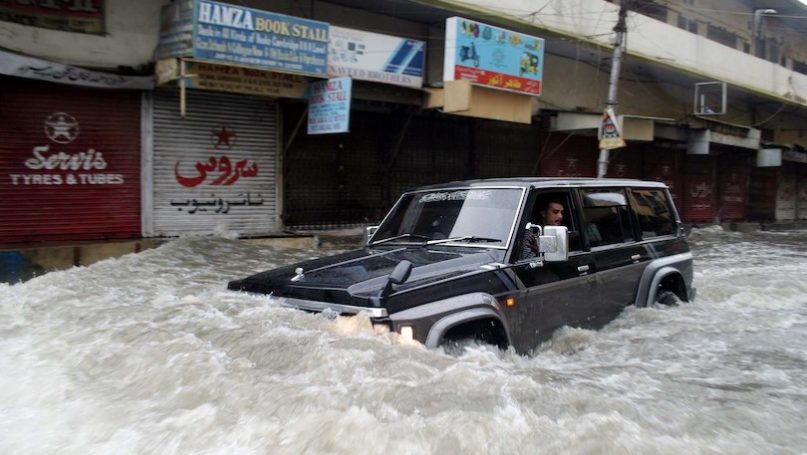
Over the past few years, extreme events due to unprecedented patterns of rain during monsoon have become increasingly frequent. In 2022, 1600 deaths occurred due to flooding and lightening during monsoon in India. A total of 2,200 deaths were attributed to extreme weather conditions in a report by the Indian Meteorological Department. The 2022 floods affected 33 million people, taking around 1700 lives and damaging close to 2.2 million homes in Pakistan. Earlier this year India and Pakistan both faced a major challenge when cyclone Biparjoy made landfall. While apprehensions related to the scale of the cyclone forced the meteorological departments of the two countries to share data with each other, that was very much it when it came to collaborating on the issue. As far as disaster management and rescue operations were concerned, there was minimum communication, if any.
A world bank report cited that Bangladesh loses $1 billion dollars annually due to tropical cyclones and is at the risk of losing one-third of its agricultural GDP due to climate variability in the next three decades. These extreme weather conditions are not particular to South Asia. A study conducted by researchers from various health institutes in Europe and published in Nature Medicine said that close to 61,000 people may have died due to sweltering heat in Europe last summer. There are rapidly increasing incidences of forest fires, extreme temperatures, excessive melting of glaciers, and an overall reduction in polar ice cover. These observations make it clear that effects of climate change are visible across the world. However, the Intergovernmental Panel on Climate Change (IPCC)’s sixth assessment report notes that the most vulnerable people are disproportionately affected by the impacts of climate change and they marked hotspots of high human vulnerability in South Asia.
There is an increasing need for international initiatives for cooperation on issues related to the ever-emergent climate crisis. For countries of the subcontinent, the South Asian Association of Regional Cooperation (SAARC) could have been the perfect platform for such liaison. With the stated goals of accelerating the economic and social development of the member countries, optimum utilisation of their natural and human resources, and improvement of quality of life of their citizens, the heads of state of seven south Asian states had signed the Dhaka declaration in 1985, institutionalising international regional cooperation in South Asia. At that point in history, SAARC was seen as an important grouping representing solidarity of the global south and a testament to the fact that the developing nations need to cooperate to fare better in this world.
It was also seen as a platform where the political differences of the member nations could be discussed and as a permanent space for dialogue that would help prevent regional relations from going into paralysis in case of political tensions. However, it turned out that instead of becoming a platform for solving interstate disputes, SAARC became a theatre where political differences between member nations were highlighted and exacerbated. In the earlier years of its existence, there were delays, cancellations, and boycotts because of the strained relations between India and Sri Lanka. At the time, Sri Lanka was protesting the presence of Indian troops in its territory. In the early nineties, the site of difference shifted from India-Sri Lanka relations to India-Bangladesh relations which became particularly tense after the Babri Majid demolition in India which provoked strong and often violent responses from religious groups in Bangladesh. For most part of its 37-year history however, it is the India-Pakistan rivalry that has often paralysed the functioning of SAARC. In the 38 years of its existence, only 18 annual summits have been held while others faced cancellations and postponements.
The differences that have hindered the cooperation of the member nations can be attributed to competing national interests, border and territory disputes, and cross-border movement of terrorists. For a region as diverse as South Asia and with such a convoluted history, it is understandable if agreements are difficult to arrive at. There is however, one point where all these nations can agree. Climate change is wreaking havoc. The vulnerable climate of the Himalayas, the flood prone river planes and the long coastline are all under threat as seasons become more and more unpredictable and changes in agricultural and monsoon patterns are observed. Problems such as the climate crisis do not recognise the political boundaries and cause devastation across borders.
Climate change threatens to be the biggest challenge nations of the subcontinent face. Thus, cooperation between South Asian nations in the face of such great difficulty is not only logical but also necessary. A common minimum program that allows consistent communication, sharing of disaster management resources, and joint planning for combating climate change in South Asia may be a lot more effective than separate national plans which will at best be partially fruitful. SAARC made many promises when it came into existence 38 years ago. Today, it seems to be in no position to deliver on many of them. However, it needs to be revived and made functional; at least for matters related to climate change.
Further Reading on E-International Relations
- Opinion – Post-COVID-19 Climate Change Politics
- India’s Health and Climate Inequities: Navigating the Global North-South Divide
- Reflecting on a Career Researching Climate Change and Security in North Korea
- Opinion – The World Bank’s Comprehensive Climate-Centric Transformation
- Reflecting on Democracy, Corruption and Climate Change in the COVID-19 Era
- From Rio to Paris: International Climate Change Treaties Between Consensus and Efficacy